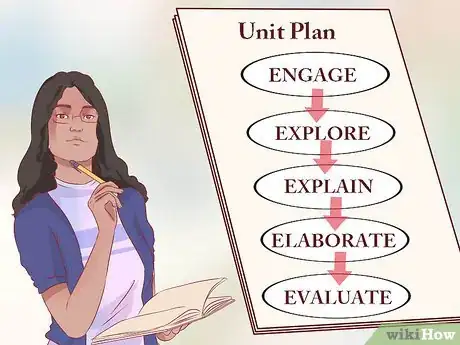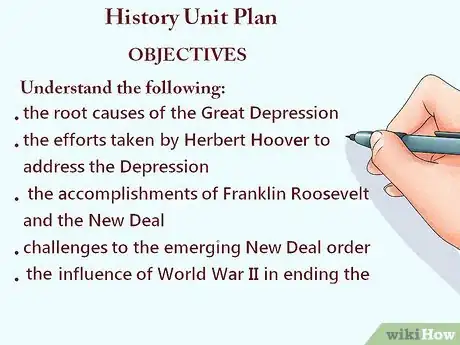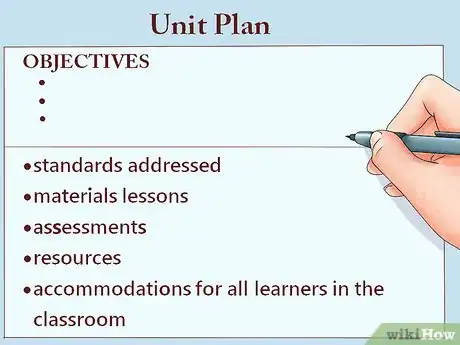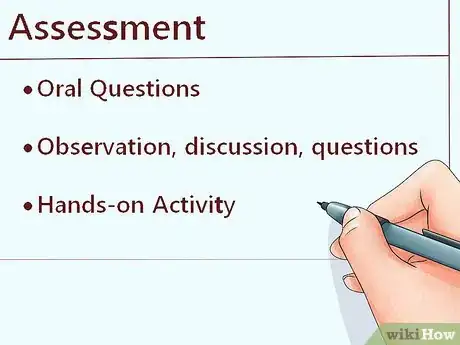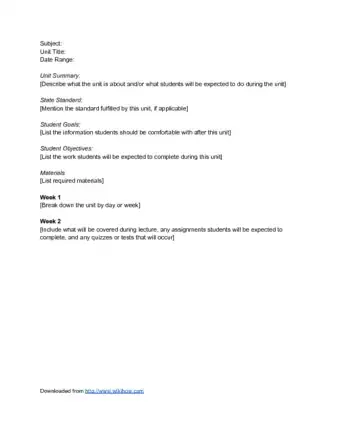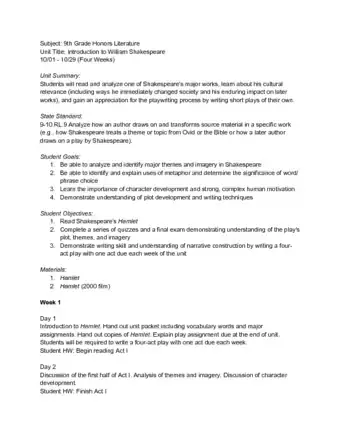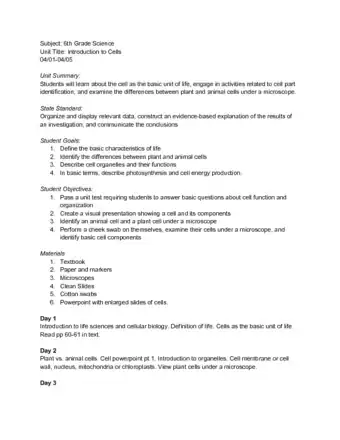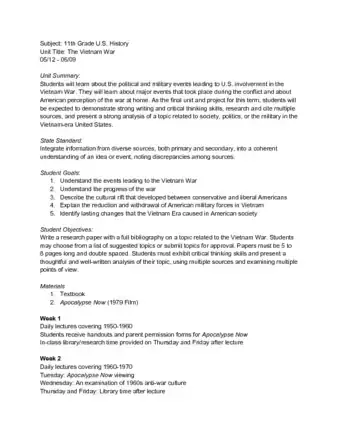This article was co-authored by César de León, M.Ed.. César de León is an Educational Leadership Consultant and currently serves as an Assistant Principal for the Austin Independent School District in Austin, TX. César specializes in education program development, curriculum improvement, student mentorship, social justice, equity leadership, and family and community engagement. He is passionate about eradicating inequities in schools for all children, especially those who have been historically underserved and marginalized. César holds a Bachelor’s degree in Education and Biology from Texas State University and a Master’s degree in Educational Leadership from The University of Texas at Austin.
There are 7 references cited in this article, which can be found at the bottom of the page.
wikiHow marks an article as reader-approved once it receives enough positive feedback. In this case, 100% of readers who voted found the article helpful, earning it our reader-approved status.
This article has been viewed 276,832 times.
As a new teacher or educator, it can be overwhelming to face all the responsibilities in writing a good unit plan that maps to all the audiences in your classrooms. Successful unit plans help you organize individual lessons into a coherent structure. Careful attention to advance planning will provide important benefits for both you and your students. You may use a variety of approaches toward unit planning, from short- and long-term outlines to interdisciplinary unit plans shared with instructors in other departments.
Things You Should Know
- A unit plan is a broad overview of a set of lessons; a unit may take an entire quarter, a specific topic you’ll cover, or a set of educational standards.
- You must identify the objectives and standards that you’re going to cover over the course of the unit.
- Include the topics, materials, and assessments that you’re going to use to measure learning outcomes.
- “Backmapping” or “backplanning” is one of the most popular methods for unit planning and it involves mapping out the standards and objectives first and then working backwards to select materials and activities.
Steps
Understanding Unit Planning
-
1Adopt unit plans to create connections for your students. At its most basic level, unit planning ensures you are linking each lesson plan to the next. As you develop a unit plan you'll support key concepts and learning goals with a carefully mapped structure.
- Use unit planning to weave key concepts and learning goals together over time and between or among disciplines.
- Consider overlapping lessons with fellow instructors to provide longer spans of time for study and practice.
-
2Diversify your instructional approach to help meet the needs of more students. You may use unit plans within your specific course. Unit plans are also an excellent way to forge interdisciplinary connections. Developing a multi-lesson unit structure provides you with a framework for presenting overarching themes in a variety of ways. Students with diverse learning styles will benefit, and you will be able to explore different ways of teaching without veering off course or running short on time.[1]Advertisement
-
3Plan for longer periods of time so you're forced to pace yourself. Planning out several units over the course of a term, or even the entire year, will help you recognize what you can and cannot accomplish during a given period of time. Once you've recognized your limitations you can prioritize key concepts and learning goals.[2]
-
4Map units to provide yourself with clear guidelines. Understanding your broad goals gives you the freedom to have fun developing unique and engaging lessons that will help your students meet these goals.[3]
Planning Short-Term Units for Specific Courses
-
1Define your objectives. Writing a clear goal for each lesson and activity will help focus the learning of your students and your teaching.[4]
- For example, if you're planning a history unit on the Great Depression, you may want students to understand 1) the root causes of the Great Depression; 2) the efforts taken by Herbert Hoover to address the Depression; 3) the accomplishments of Franklin Roosevelt and the New Deal; 4) challenges to the emerging New Deal order; and 5) the influence of World War II in ending the Depression.
- Use these five goals to plan lessons and activities that will meet these goals.
-
2Follow a standard template for preparing a unit. Normally, these begin with objectives, but also include standards addressed, materials, lessons, assessments, resources, and accommodations for all learners in the classroom.[5]
- The templates provided at the end of this article may be useful for course planning.
-
3Survey your resources. Take some time to review what resources are already available to you. Often, there are good resources already in use and taking the time to use a previous lesson or learning methodology will save a lot of time in the long run. Consult experienced fellow teachers; many times they will be willing to share plans and ideas.[6]
-
4Study the state standards and become knowledgeable about the actual content/subject matter of your unit plan. Forty-two states and the District of Columbia use the Common Core State Standards, with Alaska, Indiana, Minnesota, Nebraska, Oklahoma, South Carolina, Texas, and Virginia retaining different systems. You will be held accountable for meeting these standards; clearly understanding how your unit addresses state standards will make it easier for you and your school to report on outcomes.[7]
- If your school doesn't teach based on state-adopted materials, work with the department chair or administrators in your building to plan out a successful unit.[8]
-
5List in sequential order the major concepts in outline form to be clear on what concepts you are planning to teach within a given time frame. This exercise will help you understand how much material you can realistically fit into a unit and how you should allocate your time. Remember to leave room for adjustment. You may find that in practice, a given concept takes more or less time to convey than anticipated.[9]
- If, for example, you have four weeks to address the five Great Depression unit goals outlined above, you may opt to begin with three lessons on the Depression's root causes and end with two focused upon the influence of World War II in ending the Depression. In between, you might allocate roughly a week to each of the other three goals, but leave a "float" day or two built into the schedule.
- Plan supplemental assignments for "float" days that, while enriching, are not required material for meeting state standards. You'll be well-prepared if you do need the lessons, but you'll retain the capacity to sacrifice this material in favor of spending an extra day on a key learning goal.
-
6Plan and create your assessment tools. After reviewing what resources you can pull from, creating a diversity of assessment tools to evaluate learning is next. Both formative and summative measures should be in place to ensure a broad evaluation of the objectives is met by all students.
- Formative assessments monitor student learning to provide ongoing feedback. These tools help you understand how well students are grasping course material so you can make adjustments as you go. Formative assessments typically have little or no point value -- they are meant as a check for the instructor and not as an assessment of student performance.[10] A formative assessment tool for our Great Depression example might be a request that students submit two key points gleaned from a lecture on the First Hundred Days of the New Deal.
- Summative assessments evaluate student learning and are typically given at the end of an instructional unit. These tools typically have high point value as they do gauge student performance.[11] A summative assessment tool for our Great Depression example might be a research paper on a topic of the student's choosing.
-
7Pick and choose the lessons. Given the time and the needs of your students, select what fits their learning styles and approaches that will garner their curiosity and interest. Variety will ensure that diverse needs are met.
- Our unit on the Great Depression, for example, might mix periodic lectures with examination of primary source documents, conversations about images of the Dust Bowl, audio recordings of some of Franklin Roosevelt's "Fireside Chats," and viewing of the film The Grapes of Wrath.
-
8Have benchmarks in place. Once the unit has begun, have benchmarks to maneuver through the unit. This will help keep you on track for time and ensure that learning objectives are being met.[12]
- Formative assessments can provide useful benchmarks.
- Plan points at which you will commit to move onto new material even if student understanding remains incomplete. Spending too much time on one segment of your unit sacrifices the others.
Planning Backward
-
1Start your unit planning by considering your goals for the year. Starting with your broadest "road map" will provide important insight into how you should allocate your time.[13]
- What state standards are you required to fulfill in this course?
- What are your district's course curriculum requirements?
- What are your students' specific needs and learning styles? Consider broad factors such as demographics and past assessment data, but also trust your instincts as you consider the dynamics of your student population.
- A broad "road map" allows you to circumvent common pitfalls such as running short on instructional time. When planning a post-Civil War U.S. history course, for example, if you begin with the understanding that you'll end the course in 2001 you can plot out a series of units that will enable you to reach that goal.
-
2Develop a series of essential questions that will guide your students toward understanding of course content. These questions will form the superstructure of your course content.
- Identify key content, skills, and vocabulary. What will your students need to know when they exit your course?
- Develop ways of assessing your students to determine whether they are learning this information. Remember to diversify your assessment tools; some students will respond better to certain forms of assessment than others.
- Design a structure that will place these essential questions in a proper learning sequence. Now you have your units, and can focus upon specific lesson plans.
- Determine what materials you'll need to properly teach these concepts and skills.
-
3Refer back to your superstructure as you plan distinct units. Remember to leave room for adjustment; some units will proceed more smoothly than others. Generally speaking, however, too much preparation is better than not enough -- plan with the understanding that you may need to trim extra detail. A wise approach will focus on key concepts and then supplement with supporting material that can be sacrificed if necessary.
Crafting Interdisciplinary Units
-
1Work with fellow teachers to meet key standards and goals across disciplines. One of the greatest benefits of unit planning is the latitude it offers for developing interdisciplinary strategies to meet student needs. By planning ahead, you'll set a structure in place that gives students the opportunity to view broad concepts from many different angles.
- A history teacher undertaking a unit on the Great Depression, for example, may opt to combine forces with an instructor in a related field such as economics or political science. He or she could also travel further afield and coordinate lessons with a science instructor. The history of the Dust Bowl will gain new life from the scientific insight a biology or earth sciences instructor brings, while the science teacher's students will better understand soil science, erosion, and air currents due to the context provided by their study of Dust Bowl history.
-
2Find useful partners. A good interdisciplinary relationship will involve two or more instructors eager to work together to meet student needs. Ensure your colleague(s) will contribute similarly to the overall unit planning workload.
-
3Think creatively about how your disciplines overlap. Scientific research, for example, includes research, reading, and writing -- all hallmarks of English and language arts instruction. If you are a language arts teacher, consider coordinating with your school's biology teacher to coordinate lessons on research and analytical writing with a unit that will require students to write a research report on invertebrates. History or social studies teachers may coordinate with language arts instructors so students are studying the history of the Civil War at the same time they read The Red Badge of Courage.
- Following our Dust Bowl example, a science instructor's lesson on meteorology and air currents could lead to a predictive study of where students expect dust might have blown during the 1930s. The students might then share this information with their history teacher and determine the accuracy of their predictions.
- When embarking upon an interdisciplinary unit, ensure you coordinate assessment tools as well as lesson plans. Our imaginary science teacher and history instructor would need to be in communication with each other to determine how well their instruction was translating into important learning outcomes.
-
4Expand your students' exposure to key concepts and learning goals. Interdisciplinary coordination can provide your students with longer spans of class time for study and practice. Working together may allow you to spend multiple periods one day focused upon a larger-scale science project, while another day you'll use extra time on a language arts component of the interdisciplinary plan.
- Approaching the same subject from different angles helps students view concepts in a broader context. Instead of seeing that invertebrate report in isolation, they will understand it as a way to put broader research and writing skills into practice.
- Students who feel more confident in one subject than another gain the advantage of recognizing the links between their area of confidence and the skills they've previously found challenging.[14]
Sample Documents
Expert Q&A
Did you know you can get expert answers for this article?
Unlock expert answers by supporting wikiHow
-
QuestionWhat should I include in a unit plan?
 César de León, M.Ed.César de León is an Educational Leadership Consultant and currently serves as an Assistant Principal for the Austin Independent School District in Austin, TX. César specializes in education program development, curriculum improvement, student mentorship, social justice, equity leadership, and family and community engagement. He is passionate about eradicating inequities in schools for all children, especially those who have been historically underserved and marginalized. César holds a Bachelor’s degree in Education and Biology from Texas State University and a Master’s degree in Educational Leadership from The University of Texas at Austin.
César de León, M.Ed.César de León is an Educational Leadership Consultant and currently serves as an Assistant Principal for the Austin Independent School District in Austin, TX. César specializes in education program development, curriculum improvement, student mentorship, social justice, equity leadership, and family and community engagement. He is passionate about eradicating inequities in schools for all children, especially those who have been historically underserved and marginalized. César holds a Bachelor’s degree in Education and Biology from Texas State University and a Master’s degree in Educational Leadership from The University of Texas at Austin.
Educational Leadership Consultant First, include the material that you're covering, which should primarily come form the book you're using for that class. Be mindful of how much material you include in the unit—make sure it's easily digestible for your students. Then, include assessments like quizzes and tests to test whether your students understand what you're teaching.
First, include the material that you're covering, which should primarily come form the book you're using for that class. Be mindful of how much material you include in the unit—make sure it's easily digestible for your students. Then, include assessments like quizzes and tests to test whether your students understand what you're teaching. -
QuestionWhat's the importance of a unit plan?
 Anna Bauer - SLE StudentCommunity AnswerIt is pretty important. It a template on how to teach. It also tells you what the students need to learn.
Anna Bauer - SLE StudentCommunity AnswerIt is pretty important. It a template on how to teach. It also tells you what the students need to learn.
Warnings
- You must have the resources for the activities before you begin planning the lessons you choose.⧼thumbs_response⧽
- You must stick to a timeline to complete a unit.⧼thumbs_response⧽
- You must be aware of teaching standards as well as subject matter standards.⧼thumbs_response⧽
References
- ↑ http://www.ascd.org/publications/books/109051/chapters/Lesson-Plans-and-Unit-Plans@-The-Basis-for-Instruction.aspx
- ↑ https://iris.peabody.vanderbilt.edu/module/cnm/cresource/q4/p15/
- ↑ https://cte.smu.edu.sg/approach-teaching/integrated-design/lesson-planning
- ↑ https://iris.peabody.vanderbilt.edu/module/cnm/cresource/q4/p15/
- ↑ https://drexel.edu/soe/resources/student-teaching/advice/how-to-write-a-lesson-plan/
- ↑ https://cte.smu.edu.sg/approach-teaching/integrated-design/lesson-planning
- ↑ https://drexel.edu/soe/resources/student-teaching/advice/how-to-write-a-lesson-plan/
- ↑ César de León, M.Ed.. Educational Leadership Consultant. Expert Interview. 11 November 2020.
- ↑ https://cte.smu.edu.sg/approach-teaching/integrated-design/lesson-planning
- ↑ https://www.cmu.edu/teaching/assessment/basics/formative-summative.html
- ↑ https://www.cmu.edu/teaching/assessment/basics/formative-summative.html
- ↑ https://iris.peabody.vanderbilt.edu/module/cnm/cresource/q1/p04/#content
- ↑ https://drexel.edu/soe/resources/student-teaching/advice/how-to-write-a-lesson-plan/
- ↑ http://www.ascd.org/publications/books/109051/chapters/Lesson-Plans-and-Unit-Plans@-The-Basis-for-Instruction.aspx
About This Article
Before you write a unit plan, start by writing clear goals for what you want your students to get from the unit. Then go online to get a standard unit planning template, which can help you work through a plan to meet those goals. One thing you’ll need to do is look at the learning standards for your state, and figure out in your plan which lessons should address which standards. You’ll also want to outline the major concepts to be covered and decide how much time you can spend on each concept, given the unit's time frame. For more information on how to write a unit plan, including for an interdisciplinary unit, scroll down!



